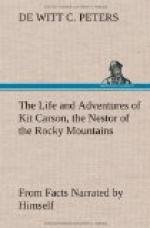The money realized, so far as Kit’s two comrades were concerned, was soon expended in fleeting pleasures and a new outfit for the next trapping expedition which might offer. Kit’s former experience had been sufficient on this score, and he had become impressed with the highly important fact that there existed a much wiser course to be pursued. With his characteristic consistency, Kit acted upon this conviction and wisely saved his hard earnings.
While remaining at Taos, Kit Carson met with Captain Lee, formerly of the United States Army; but, at this time, a partner of Bent and St. Vrain, two names as familiarly known to the mountaineers as the household words of their boyhood days.
Captain Lee was purchasing goods for the purpose of trading with and supplying the trappers. He desired Kit Carson to join in his enterprise and made him an offer which was accepted.
In the latter part of October 1832, with their goods well packed and properly fitted for the rough transportation which they must necessarily be subjected to, they set out to find the trappers. They traveled for some distance on a route well known as the “Old Spanish Trail.” This is nothing more than a mule path which leads from New Mexico to California.
Having arrived safely at White River, they continued their march down stream, following the windings of the river until they came to Green River. Green River, they forded and then struck across the country for the Winty River which is a branch of the Green River.
Here they found Mr. Robidoux who had a party of twenty men in his employ and who was engaged both in trapping and trading according as opportunity presented itself. Soon after these parties met, snow began to fall, indicating the approach of the cold season. A mutual understanding having been arrived at, the two parties joined together and began to establish Winter Quarters suitable for the whole.
They selected a site for their permanent camp on the Winty River, at its mouth, where the men made themselves as comfortable as possible under such circumstances. They were provided with skin lodges, so common among the Indians of America, and which according to Kit’s mountaineer experience are very comfortable substitutes for houses.
During the winter Mr. Robidoux lost six of his most valuable and high-priced horses, in the following manner. Attached to the camp there was a California Indian who was employed by Mr. Robidoux, a keen and shrewd savage: and one, whose acquaintance with the trappers had enabled him to gain the confidence of Mr. Robidoux. He was also an expert with the rifle and possessed undoubted courage with great bodily strength and activity. These qualifications made him a troublesome customer in a skirmish.
This Indian’s education on the score of property rights had not been as well attended to as the methods of attack and defence in the chase and on the war path. By some, not strange, personal argument, he concluded to appropriate the six valuable horses above mentioned, in the law wordy vocabulary of civilization, “to his own, use, benefit and behoof, without asking the consent, good-will, approbation, permission and personal, directions of the said owner, to wit Mr. Robidoux.”




